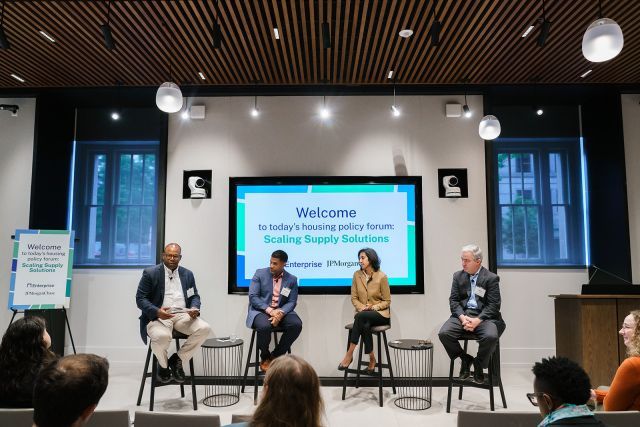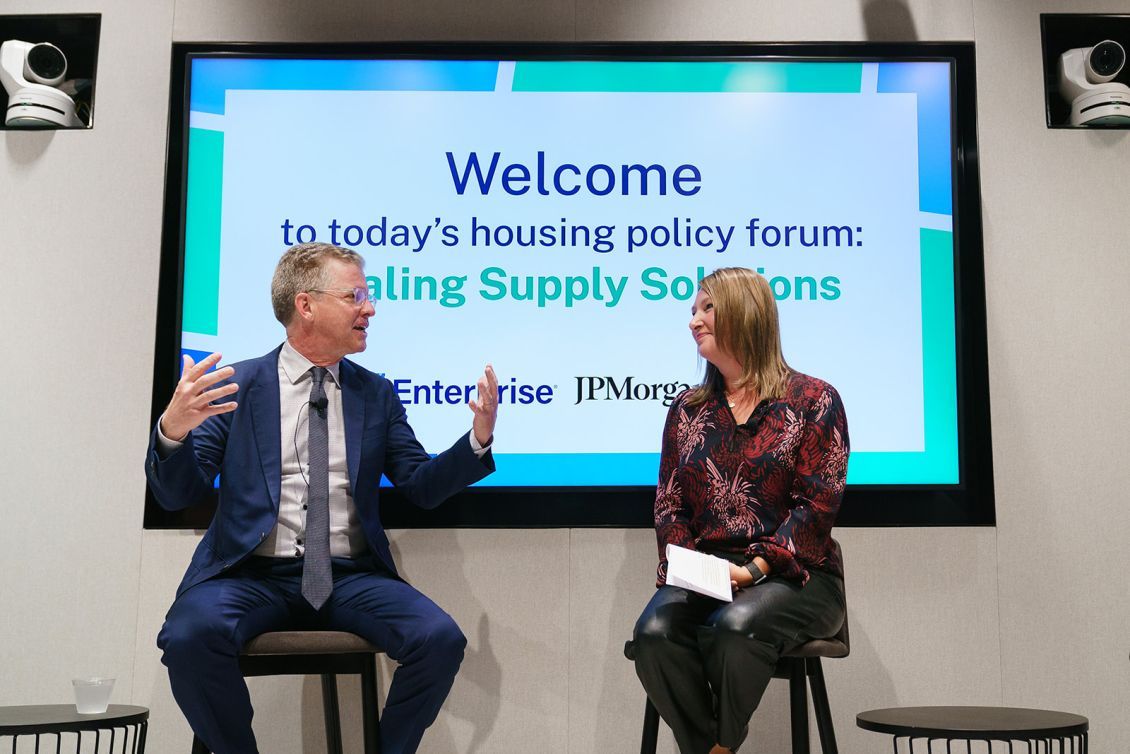Homeowners and renters nationwide are struggling with high housing costs, underscoring the urgent need to expand the supply of affordable housing.
Enterprise and JPMorganChase recently convened experts to discuss financing and regulatory barriers that inhibit affordable housing production, as well as promising strategies to address these challenges. The housing policy forum, Scaling Supply Solutions, opened with a fireside chat featuring Enterprise CEO and President Shaun Donovan and Heather Higginbottom, Head of Research, Policy & Insights, Corporate Responsibility, JPMorganChase.
In a wide-ranging discussion, Higginbottom spoke with Donovan about the origins of the national housing shortage, overcoming regulatory- and financing-related barriers, and the importance of preserving affordable homes.
Heather Higginbottom: We have a national shortage of over four million homes, a gap that goes up to seven million homes when you factor in affordability for lower-income families. How did we get here?
Shaun Donovan: We had a chronic housing shortage that became acute after the Covid-19 pandemic created additional barriers to housing production. The impacts of factors like the very-low construction levels during the Great Recession from 2007 to 2009 were exacerbated by pandemic-induced factors such as higher construction and operation costs, as well as spiking insurance premiums and interest rates.
H.H.: We know that finding solutions to regulatory barriers is critical to addressing the housing supply gap. What types of regulatory reforms have been working?
S.D.: An increasing number of states and localities have been adopting land use and zoning reforms to allow for more housing types and density. One jurisdiction that has been getting lots of attention is Minneapolis, where regulatory reforms helped cool down market-rate rents. Pew research shows that Minneapolis increased its housing stock by 12% between 2017 and 2022, and rents only grew by 1%. We’ve seen successful reforms that would have a more significant impact if they were implemented at scale. Enterprise’s research estimates that, if homeowners and developers nationwide took advantage of the opportunity to add an accessory dwelling unit (ADU) at the same rate as in Los Angeles in the most recent years, they would collectively build upwards of 9 million new homes over the course of a decade.
H.H.: Our team in Corporate Responsibility works closely with our lines of business and our community partners, including Enterprise Community Partners, to identify emerging housing policy challenges and support innovative solutions. How can the public and private sectors work together to get more capital out to finance affordable housing?
S.D.: The public and private sectors need to work together on capital solutions that ensure we are creating affordable housing for families with low incomes as we build more homes. These solutions include expanding and strengthening the Low-Income Housing Tax Credit program, state and local housing trust funds, risk sharing programs, and innovative private-led financing products.
H.H.: When we discuss supply, we often think about new construction. We continue to see troubling data about the loss of affordable housing – that can be from market pressures raising prices, but also from the loss of existing properties that fall into disrepair, which the JPMC team explored in a paper earlier this year focused on residential vacancy, abandonment, and disrepair. What can the industry do to better preserve affordable housing?
S.D.: I have never seen a moment where our affordable housing stock is as much at risk of loss, especially permanent supportive housing for people who previously experienced homelessness. We need to use important capital tools like the Housing Credit and the Neighborhood Homes Investment Act to preserve affordable homes. We are also focused on preserving affordable rural housing financed by USDA’s Section 515, as well as supporting developers and owners of unsubsidized affordable small and medium multifamily housing, who are predominantly Black, Indigenous, and People of Color (BIPOC).
H.H.: You recently celebrated your one-year anniversary as the CEO and president of Enterprise. Can you share a couple of lessons learned in year one and what you are looking forward to in the next couple of years?
S.D.: Enterprise Community Partners recently reached the milestone of creating or preserving one million homes. Amid all the challenges affordable housing providers are experiencing, it is important to remember that Jim Rouse founded Enterprise to empower local partners and communities. We will continue to support our partners to ensure that they can continue to provide affordable housing. This moment is crucial as we look to the potential of scaling federal climate investments and increasing our affordable housing stock resilience.
The fireside chat was followed by expert panel discussions on cutting through the red tape and advancing financing innovation to boost the supply of affordable homes.
Strategies discussed during these panels include:
- Adopting land use and zoning reforms to allow for more housing types and density by right, a streamlined process under which proposed housing developments that comply with underlying codes and requirements get approved without additional reviews and hearings.
Image

Ahmad Abu-Khalaf, Enterprise; Tobias Peter, American Enterprise Institute; Mike Kingsella, Up for Growth; and Angela Brooks, American Planning Association - Allowing for light-touch density or missing-middle housing — the type of density that stands somewhere between single-family homes and higher density multifamily housing depending on local context, such as ADUs, duplexes and triplexes — to create new rental and ownership housing opportunities.
- Revising outdated regulations and processes that make it less financially and physically feasible to build housing. Such records may include updating building codes and zoning requirements; research shows that easing regulatory barriers has helped cool down rent prices in jurisdictions that have adopted such reforms.
Image

Vince Toye, JPMorganChase; Christopher Tyson, the National Community Stabilization Trust; Priya Jayachandran, National Housing Trust; Mark McCann, JPMorganChase - Enacting federal proposals that would expand capital for affordable housing development, including the Affordable Housing Credit Improvement Act and the Neighborhood Homes Investment Act. These proposals would expand the supply of affordable rental housing, as well as homeownership opportunities nationwide.
- Expanding access to capital needed to both build new affordable housing, including rental and for-ownership homes, and preserve existing affordable properties that otherwise would be lost to despair or market pressures. Financial and technical assistance are also needed to support affordable housing providers experiencing significant cost challenges.
- Providing better access to innovative financing tools, including capital for emerging developers providing small and medium multifamily housing and single-family home developments that are designed to provide homeownership opportunities for low- and middle-income families.
